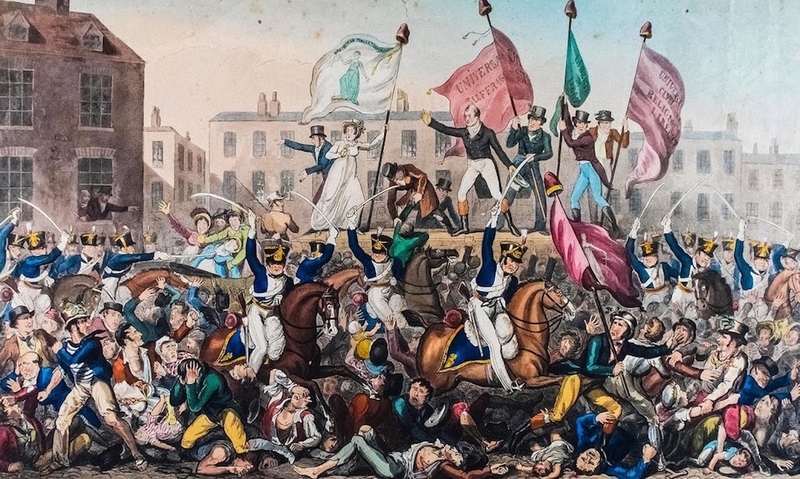Jonathan Schofield and the strange case of the flawed Jeremy Deller design
THE road to hell is paved with good intentions.
The indefatigable energy of the Peterloo Massacre Memorial Campaign seemed to have paid off beautifully when that darling doyen of engagement arts, Jeremy Deller, was commissioned to produce a work. The location seemed good as well, right on the site of Peterloo, at Manchester Central.
The Peterloo Massacre occurred on 16 August 1819 and was a defining moment in British democracy. 60,000-80,000 people gathered to protest about the lack of a vote and lack of representation in Parliament. Essentially, at a time of great hardship, people wanted a voice. The magistrates panicked and sent in the yeomanry. At least fifteen people were killed and many hundreds injured.
The memorial as it stands is a glaring metaphor for inequality and segregation
Deller’s memorial seemed like a good idea. A stepped mound, covered in artworks marking personalities from the time, incidents and places. The mound would act as a podium from which a speaker might lead a crowd, as Henry Hunt had done two hundred years ago.
The problem is the design which makes access difficult in an age of access being a legal obligation. Mark Todd, a seasoned campaigner for disabled rights, is one among many to point out "the hypocrisy of a memorial dedicated to those who marched demanding liberty and equality for all, being designed and built with inequality at its heart."
A Manchester City Council spokesperson said: ‘We have engaged, and will continue to engage, with people who are disabled in order to make this memorial accessible while recognising this is not a building or similar structure but a piece of public art.
"Significant changes to the original design were made in response to this dialogue throughout the design's development including the incorporation of a ramp and handrail and the replacement of tiles covering the memorial with stone to reduce slip hazards. The specific design elements which provide information about Peterloo are all accessible.
‘We have taken these considerations seriously. While we respect the fact that some people feel that these changes still do not go far enough, we believe we have done the best we realistically can allowing for the constraints of the site - and this is the only feasible site in the original Peter’s Fields area. Further mooted changes to the approved and already amended design would require new planning approvals and mean the project couldn't be completed in time for the 200th anniversary commemorations.'
‘Manchester is a city which prides itself on being both inclusive and radical but we recognise that there is always scope for improvement and want to build on the constructive dialogue we have had with disabled access groups to help inform future design decisions.’

Mark Todd refutes some of these claims.
“Firstly,” says Todd, “this million pound structure is a monument that's for the public to inhabit - to be one to hang around on and a place to assemble. It is not something to be looked at and not touched - it is something to be on. All the artist's impressions show it completely covered in people with a token wheelchair user sat at the bottom not taking part. The council are right to say this is ‘public art’ and guess what, we, the disabled, are the public too. We would like some of the million pound budget spent on making it accessible to all Manchester citizens.
“The Council have made a tiny change once we pointed out the mistake but to call it ‘significant’ is a distortion,” continues Todd. “Jeremy Deller's mound is about 72 inches high, the change they call significant is a wider step a pathetic 7 inches off the floor, you can buy high heels taller than that. We proposed a compromise solution for a curved ramp providing a speaking platform 29 inches off the ground, dining table height, so that a wheelchair user would be raised up just enough to address a crowd.
“We had an early drawing which Jeremy Deller said was 'workable' and required no more space, staying within the agreed footprint. The next stage was to make it safe and more elegant. Jeremy Deller, the Peterloo Memorial Campaign, and artists involved in the Peterloo 2019 festival and hundreds of ordinary citizens want it to be accessible.”
To Mark Todd, the changes don’t amount to a hill of beans, with “a poorly designed handrail and a neither use nor ornament ramp”. He believes the city council have “cocked up a million pound project during a time of austerity and don't want to admit it. This is about them saving face, nothing else.”
The city refutes this, of course. Yet attempting to retrofit access does seem an extraordinary and glaring error in 2019. The city need only to have looked around the corner at its own work. Several years ago, the council built the Library Walk link building between Central Library and the Town Hall Extension. The link building cost a fortune, £3.75 million, and part of that huge cost was to create long ramps on each side to allow full disabled.
Meanwhile, not 30 metres away, is the cross that marks the site of St Peters Church. This Temple Moore-designed work sits atop several steps, which look not unlike the new Peterloo Memorial. It was St Peters Church at Peter’s Fields and the Battle of Waterloo four years earlier which formed that piece of journalistic genius that branded the Manchester massacre Peterloo. The cross was erected in 1908, 111 years ago. Things have moved on.
It is clear the new Deller work was planned in good faith and with the best of intentions, yet its deficiencies over disabled access have been pointed out for many months. Maybe much more could have been done to remedy the situation. What is clear is it’s a crying shame a shadow has been cast over the excellent work of the Peterloo Massacre Memorial Campaign, who for thirteen years have been working hard to get a permanent memorial to mark this key national moment. The last thing they wanted is a section of the population considering this “a glaring metaphor for inequality and segregation with disabled people literally being talked down to.”
It's the last thing anybody wanted.















